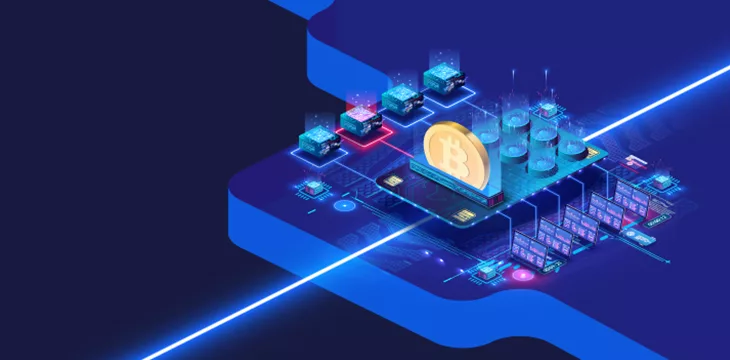If you’re interested in blockchain and its many applications, you must be ready to explore novel functions that surpass the technology’s original design. Whether for personal or business pursuits, one of the most fascinating blockchain applications involves fortifying the Internet of Things (IoT) systems.
IoT systems are dynamic tools for optimizing processes and enhancing connectivity. However, they grapple with a critical challenge: security.
Although efficient, IoT systems can have vulnerabilities that malicious actors may exploit. This guide describes how blockchain-based IoT security offers a potential solution to these issues via decentralization, cryptography, and relevant mechanisms.

What is the Internet of Things (IoT)?
The Internet of Things is a set of physical devices or objects that communicate and share data over the internet. These smart mechanisms can collect, exchange, and act upon information autonomously. As such, IoT networks can enhance automation, efficiency, and convenience in various applications.
Home security is a common example of how IoT systems can enhance functionality. A typical home security system includes motion sensors, cameras, and locks. Through IoT, home devices communicate with each other. When a sensor detects an intrusion, it triggers the cameras to record, locks doors, and sends alerts to the homeowner’s smartphone.
Major Components of an IoT System
The four crucial components in every IoT system are:
1. Sensors and smart devices
These physical things give the IoT system part of its name. The sensors collect and transmit data from the physical world to a central network. Their role is to enable real-time data acquisition, monitor environmental conditions, and execute actions.
2. Cloud connectivity
The devices must send their data somewhere, which is where cloud connectivity comes in. It means the cloud is the central hub, storing the data and the tools to process it. Meanwhile, the physical IoT parts have a link between devices and remote servers for data storage while providing easy access for other parties from any location with internet connectivity.
3. Data analysis
Specialized tools make data processing and analysis possible by examining vast amounts of data from sensors to derive actionable information. Through data analysis, IoT systems can determine appropriate responses to specific stimuli.
4. User interface
In IoT systems, user interface is the part that lets you interact with devices in the network and access the data they generate. They’re often digital, via applications or web interfaces, for users to monitor the status of IoT devices, receive notifications, and make adjustments.
6 Benefits of Blockchain-Based Security for the IoT
Blockchain integration into IoT creates a combination more remarkable than its parts. This innovative fusion of technologies is a game-changer due to these critical advantages.
1. More robust security
When integrating blockchain security, you may add another layer of protection by including a check valve into your IoT system. To function, it will require a micropayment of a token or valueless coin to verify more sensitive operations. This transaction means that even during a malicious attack, Bitcoin private keys will stop a system from being overrun or used as a free botnet.
Due to blockchain’s unique architecture, it can serve as a secure digital stronghold for potentially sensitive IoT data. It reinforces security by storing your information in a tamper-proof and decentralized infrastructure that comprises a network of computers, making it difficult for cyber intruders to compromise your system.
2. Significant supply chain improvements
Blockchain serves as a transparent, digital ledger for supply chains. It can record every step of a product’s journey in an easily traceable way. This functionality reduces errors, fraud, and delays in the supply chain, ultimately benefiting both producers and consumers.
3. Reduced operational costs
Blockchain automates processes and eliminates go-betweens, slashing your operational expenses. By using IoT systems, you can develop more efficient operations and pass the savings on to other expenditures.
4. Expedited accounting process
Time is money in the world of accounting. Blockchain’s real-time data updates and automated transactions accelerate accounting tasks, making financial management smoother, faster, and more accurate.
5. Faster data exchanges
Blockchain is like a private road for your data, where your network can have swift and protected exchanges. All your connected devices can stay up-to-date and responsive without as much traffic, resulting in more timely decision-making.
6. Global interoperability
An IoT system operating on a blockchain like Bitcoin Satoshi’s Vision (BSV) can act as a universal translator for other devices on the same chain. A widely used blockchain type can bridge the gap between systems worldwide, letting all layers of the community communicate effortlessly.
6 Challenges of Blockchain-Based IoT Security
While blockchain IoT security presents many promising benefits, a few significant roadblocks still stand in the way of total adoption.
1. Resource-intensive
The robustness of blockchain-based security comes at a cost⎯that is, it requires substantial computational power and energy despite efforts to minimize this demand. This issue can be a stumbling block for less capable IoT devices that lack the muscle to handle system requirements efficiently.
2. More demanding to scale
As your IoT network grows, so do the demands on your chosen blockchain type. It’s like managing a rapidly growing city. The more extensive the network, the more intricate and expensive it is to maintain its smooth operation and scalability.
3. Network security and transaction privacy
The balancing act required to achieve both security and preserving privacy can be a delicate process for IoT blockchain networks. IoT systems need data to function, but collecting said information raises concerns about user privacy. While blockchain offers tamper-proof records, IoT devices themselves can serve as potential entry points for attackers.
4. Overdependence on sensors
Even sensors encounter data accuracy and reliability issues, particularly as they age or experience damage. Your entire digital infrastructure relies on these devices to produce accurate and consistent information. Depending on your setup, you may need frequent maintenance and replacement to upkeep their quality.
5. Compatibility issues
While security is an ideal application of blockchains, some types of blockchains can handle only a specified set of information. For instance, IoT devices on identical blockchains can interact seamlessly, but outsider devices may have to go through extra steps before they can interface.
6. Regulatory and legal complexities
Both blockchain and IoT are relatively new technologies. As such, navigating each one’s rules and regulations can be intricate. Plus, new restrictions and compliance requirements resulting from the fusion of these technologies can introduce unexpected challenges and hurdles along the way.
6 Blockchain-Based Security Solutions for IoT Systems
The demand for robust digital security will exist as long as people store data online. Here are the ways blockchain can fill that demand thanks to its unique design.
1. Cryptographic algorithms
Cryptographic algorithms are advanced mathematical techniques that blockchains use to encrypt peer-to-peer data transfer. In addition to peer-to-peer encryption, blockchains employ hashing, a process that transforms data blocks into a unique string of characters as permanent records. Even a tiny change in the input data will result in an entirely different string.
Applying this dual layer of protection to IoT systems, it’s nearly impossible for unauthorized parties to access or tamper with any recorded data. This security method is a fundamental factor that makes blockchain suitable for safeguarding IoT data.
2. Decentralized device authentication and communication systems
IoT devices can verify each other’s identities directly through blockchain without relying on a central authority. Intermediaries introduce vulnerabilities, as a single point of failure can jeopardize the entire system’s security. Blockchain’s capacity for decentralized authentication minimizes the risk of impostor devices entering your network.
3. Smart contracts
Smart contracts⎯ a core feature of blockchains⎯are self-executing agreements with the terms and triggers directly written into code. These actions automatically take place when the system detects the predefined conditions. They are visible to all participants, enabling automated interactions without relying on third-party entities.
In IoT systems, smart contracts can:
- Automate the payment of repeated expenses like data usage or services
- Interact with devices autonomously based on set conditions
- Facilitate tracking and payment of goods in IoT-based supply chain systems
4. Consensus mechanisms
Systems in a blockchain rely on the distributed network’s consensus mechanisms to autonomously confirm transactions. When an action occurs within the blockchain, the system broadcasts it to all the computers in the network. These nodes work together to validate the transaction and ensure it complies with the chain’s predefined rules.
This intricate mechanism ensures that every participant in an IoT network unanimously agrees on the same set of rules related to the transaction data. It’s another layer of security that prevents fraud and data tampering, which is a critical measure for maintaining data integrity.
5. Device interaction ledger
The way blocks in the chain string together through hashing makes them an immutable logbook of all IoT network interactions. At the same time, you have a clear history of who did what in your data or communication system. Changing or erasing the records is not feasible while the blockchain exists.
6. Device coordination system
IoT devices in a blockchain rely on a secure, automated system to coordinate their activities, share data, and interact seamlessly. Thanks to smart contracts and consensus mechanisms, there’s no room for human error, and all connected objects follow the rules and conditions the blockchain sets.
Securing Tomorrow’s World Through Blockchain
The Internet of Things (IoT) offers convenience for personal and business transactions. Amid the obstacles in organizing and processing online data, blockchain is shaping to be the ideal solution for IoT security vulnerability. Challenges like scalability and regulatory complexities may be present, but blockchain-based IoT’s potential is undeniable.
Eager to learn more about the subject? CoinGeek is the perfect introduction to this game-changing technology. Head to our blockchain for beginners section to immerse yourself in the digital future!

 12-22-2025
12-22-2025 


